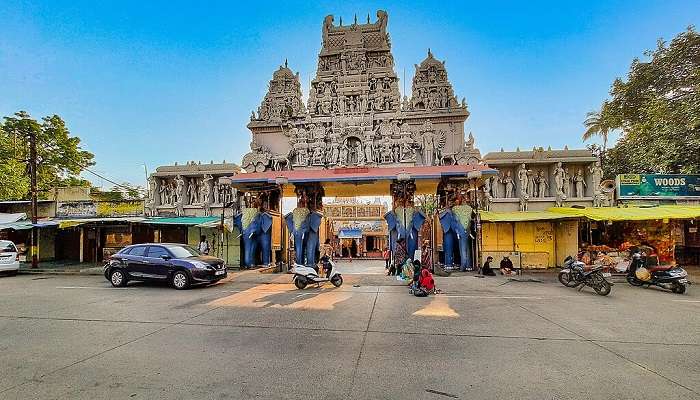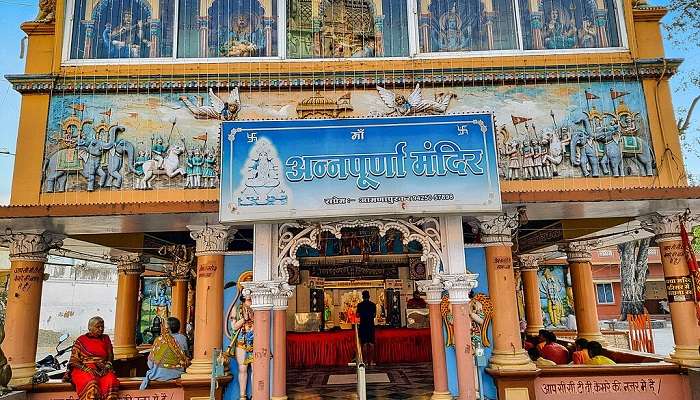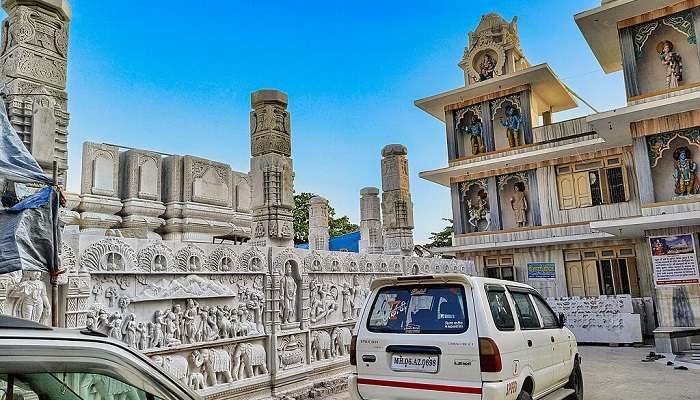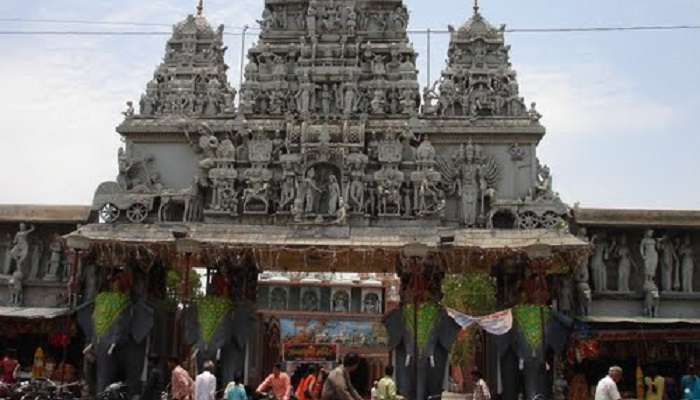Visit Shree Annapurna Temple Indore And Get Complete Guide To Spiritual Landmark

Have you ever wondered who nourishes the Gods themselves? According to Hindu belief, it’s the responsibility of the Goddess Annapurna, who is the embodiment of sustenance and prosperity. Moreover, Shree Annapurna Temple Indore, which is dedicated to Goddess Annapurna, is a temple in Varanasi that provides a unique kind of experience for every devotee and even visitors. Moreover, this temple was constructed in the 18th century and hence holds a religious significance. Devotees here worship goddess Annapurna and seek her blessings, as she is the god of fulfilment and abundance of basic needs.
Moreover, the temple’s structure was built under Maratha architecture and is beautifully carved with intricate adornments. If you plan to visit Shree Annapurna Temple, it’s more than a truly immersive experience. Devotees from all corners of the nation visit this temple to offer their prayers and participate in the traditional rituals.
All You Need To Know About Shree Annapurna Temple Indore

Shree Annapurna Temple is dedicated to the goddess Annapurna, the embodiment of sustenance and prosperity. This temple in Varanasi holds immense cultural significance and offers a unique experience for those coming here for devotion. Built in the 18th century, it attracts devotees willing to seek blessings and fulfil basic needs. Moreover, the temple showcases the local traditions and architectural styles. This temple houses shrines dedicated to other deities like Shiva and Hanuman and highlights the interconnectedness of the Hindu deities.
Moreover, the charm of Shree Annapurna Temple lies quite further than its religious significance. Devotees who visit this temple often participate in traditional rituals and partake in the prasad, sanctified food blessed by the temple. Furthermore, the temple has additional attractions nearby, such as the iconic Kashi Vishwanath temple. This enables the pilgrims to seek blessings from both temples in a single visit.
Must Read: Tourist Places Near Indore
Deities Were Worshipped At Shree Annapurna Temple Indore

Although the Shree Annapurna Temple is centred mainly around the benevolent goddess Annapurna, She is the maharani of Shree Annapurna Temple. Annapurna, as the name suggests, means, “full of food” embodies the essence of sustenance and nourishment. Devotees usually flock to this temple to seek blessings for abundance, the ability to fulfil basic needs, and even the eradication of hunger. After having the darshan of the goddess, it is believed to bring good fortune and prosperity.
You will see the idol of Lord Shiva in the temple. Shiva, the destroyer and the regenerator represents the transformative power of the universe. The inclusion of Shiva signifies the importance of balance in life. In some temples, you will often find the idol of Shiva in his meditating form. Along with him is Lord Ganesha, the elephant-headed god and the remover of obstacles, who is the main symbol of auspicious beginnings. The presence of Lord Ganesha in the temple signifies the importance of seeking his blessings for a smooth and successful pilgrimage or prayer.
Daily Rituals And Ceremonies

There are a set of daily rituals and ceremonies held at Shree Annapurna Temple. Let’s have a keen glimpse of these practices below:
Mangala aarti:
The day at Shree Annapurna Temple begins with Mangala, or morning aarti, a predawn ritual mainly conducted to awaken the deities. During this aarti, the priests often chant mantras, lighten the lamps with ghee, and offer their prayers to Annapurna. The gentle clicking of the bells and the soft glow of the lamps create a soothing environment.
Abhisheka:
Followed by the mangala aarti, the temple often performs Abhisheka, a sacred bathing ceremony of the deities. Abhishek is often done with Panchamrut, a mix of milk, curd, honey, ghee, and sugar. There’s also the presence of other substances, such as coconut water and flower petals, that are poured gently onto the idol of Annapurna. This ceremony is often conducted to purify and seek the deity’s blessings.
Shringar:
As the day progresses, the priests perform another aarti—the Shringar aarti. This aarti is held to beautify the deity, after which Annapurna is adorned with a vibrant silk saree, exquisite and delicate jewellery, and a vibrant tilak on her forehead. Following this, the deity is often offered flowers, symbolising the bounty of nature.
Suggested Read: Places To Visit In Indore
The Best Time To Visit

However, it completely depends on when you want to visit Shree Annapurna Temple. However, here’s a detailed breakdown:
Off-season:
April to June and September to October are often considered the off-season when visiting Varanasi as it is quite hot. However, if you prefer to visit in smaller crowds, you may prefer to visit during these months.
Navratri:
Navaratri, a nine-day festival celebrating the divine feminine, is the best time to visit the temple. During this time, devotees can experience vibrant decorations, special pujas, and a vibrant and exciting atmosphere.
Annapurna Jayanti:
Annapurna Jayanti varies by the lunar calendar and is, hence, specifically dedicated to Annapurna. During the Jayanti, the temple sees an increase in devotees visiting to seek the blessings of the deity and to participate in special pujas.
Further Read: Things To Do In Indore
Shree Annapurna Temple Indore uniquely blends spiritual devotion and artistic beauty. Whether you seek blessings for abundance or even looking for a peaceful experience, visiting this temple in Varanasi would be a rewarding experience. So, pack your bags, book a trip to Indore, and discover the profound connection between faith, food and divinity.
For our editorial codes of conduct and copyright disclaimer, please click here.
Cover Image Credit: Ms Sarah Welch for wikimedia commons
Frequently Asked Questions About Shree Annapurna Temple
What is the significance of Shree Annapurna Temple?
Shree Annapurna Temple is dedicated to Goddess Annapurna, the goddess of nourishment, and offers blessings for abundance and well-being. The devotees visit here to seek the blessings of the goddess and pray to her to provide their families prosperity and contentment.
Who are the other deities present at the temple?
In the temple complex, you will see the idols of Lord Shiva, Lord Ganesha, Lord Hanuman, and several other deities, reflecting the interconnectedness of the divine and regional traditions. The temple complex has many shrines and boasts an impressive artwork of Hindu goddesses in various roopas or forms, such as Goddess Parvati, Goddess Durga, Goddess Saraswati and Goddess Lakshmi.
What all should be included in my visit to the temple?
At the temple, you can sit in the gopuram and chant bhajans or mantras in front of the idol of Goddess Annapurna. You can also participate in daily rituals like aarti, participate in prayers, and receive prasad, sanctified food blessed by the deity.
When is the best time to visit Shree Annapurna Temple?
For fewer crowds, opt for the off-season (April-June or September-October). To experience vibrant festivals, plan your visit around Navratri or Annapurna Jayanti.
What should I wear to Shree Annapurna Temple?
It is important for all men, women and children to dress modestly, properly covering your shoulders and knees. You need to remove your shoes before entering the inner sanctum and keep them on the shoe stand outside the temple.
People Also Read:
Golu Devta Temple Nandalay Temple ISKCON Temple Bangalore

With a passion for exploring and travelling to the roads long forgotten, experience the world through enthralling stories and adventures. Join me as I share my experiences at some of the world’s most popular tourist destinations and quench that pestering curiosity with something exciting!











